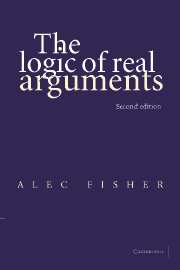Book contents
- Frontmatter
- Contents
- Preface to the first edition
- Preface to the second edition
- Acknowledgements
- 1 Introduction
- 2 A general method of argument analysis
- 3 A first example – from Thomas Malthus
- 4 Reasoning about nuclear deterrence
- 5 An example from John Stuart Mill
- 6 Arguments about God's existence
- 7 How do your mind and body interact?
- 8 Suppose for the sake of argument that …
- 9 An example from Karl Marx
- 10 Evaluating ‘scientific’ arguments. Some initial examples
- 11 Philosophical assumptions
- Appendix: Elementary formal logic
- Exercises
- Bibliography
- List of further reading
- Index
10 - Evaluating ‘scientific’ arguments. Some initial examples
Published online by Cambridge University Press: 05 June 2012
- Frontmatter
- Contents
- Preface to the first edition
- Preface to the second edition
- Acknowledgements
- 1 Introduction
- 2 A general method of argument analysis
- 3 A first example – from Thomas Malthus
- 4 Reasoning about nuclear deterrence
- 5 An example from John Stuart Mill
- 6 Arguments about God's existence
- 7 How do your mind and body interact?
- 8 Suppose for the sake of argument that …
- 9 An example from Karl Marx
- 10 Evaluating ‘scientific’ arguments. Some initial examples
- 11 Philosophical assumptions
- Appendix: Elementary formal logic
- Exercises
- Bibliography
- List of further reading
- Index
Summary
Now that we have shown how in general to handle suppositions, we have explained how to extract arguments from their context and how to represent their structure in sufficient detail for us to be able to delve more deeply into the third part of the exercise – evaluating the soundness of an argument – for a wide range of important arguments.
Remember that in order to test whether an argument is sound we have to ask,
Could the premisses be true and the conclusion false judging by appropriate standards of evidence or appropriate standards of what is possible?
and in order to establish the appropriate standards we ask the Assertibility Question,
AQ What argument or evidence would justify me in asserting the conclusion? (What would I have to know or believe in order to be justified in accepting it?)
Remember furthermore that, as we have insisted from the beginning, anyone can ‘play this game’: it is not just a matter for the ‘experts’.
Two initial examples
Suppose we encounter the claim that ‘like magnetic poles always repel’ (M). What would show that this was true or false (allowing this as a paraphrase of the Assertibility Question)? If you understand the meaning of the claim M you must be able to give some kind of answer to the question (remember principle * p. 23).
- Type
- Chapter
- Information
- The Logic of Real Arguments , pp. 143 - 159Publisher: Cambridge University PressPrint publication year: 2004



